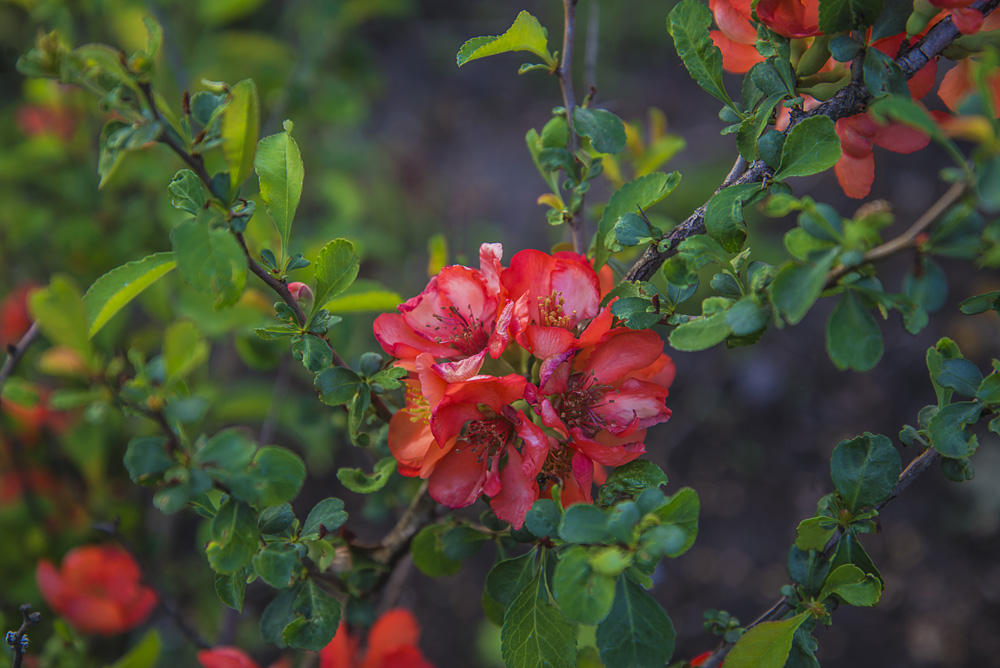Chaenomeles sp.
Common Name:
Quince

General Information:
Chaenomeles are much beloved for bonsai because of their tiny, lovely flowers, and in spite of their prickly thorns. Most varieties flower before leafing out, sometimes as early as January, and may continue to flower for a long time following. The fruit is yellow and large, too hard to be edible, but making tolerable preserves.
Taxonomists have suffered much over Chaenomeles. To begin, the species now known as C. japonica and C. speciosa were hopelessly confused when introduced into England. They were originally classified as pears, but then reclassified as quinces, and then classified as pears again! Finally, when the genus Pyrus got too large, they were given their own genus. Then the Chinese quince, Chaenomeles sinensis, was reclassified as Pseudocydonia sinensis - false-quince. To make things worse, C. japonica and C. speciosa hybridize at the drop of a hat (called C. x superba), which has made it difficult to know the true derivation of some cultivars (many are simply identified as C. ‘CultivarName’.)
Lighting:
Full sun, although partial shade in midsummer is desirable in very hot areas.
Temperature:
Protect from frost.
Watering:
Generous, but avoid misting as this damages the flowers and may rot the fruit. Reduce watering in winter, but never allow the soil to become fully dry.
Feeding:
Every two weeks from the end of flowering until fall. Some varieties have spot blooms throughout the season; these obviously still need to be fed when growing actively. Use liquid bonsai fertilizer or half- strength plant food. Proper feeding is essential for good flowering. Calcium in the soil helps to form fruit and flowers.
Pruning and wiring:
Fruiting and flowering can sap the plant’s energy dramatically, so it is wise to limit the amount by picking off developing fruit and flower buds, especially in young bonsai. Flowering quince likes to sucker from the roots. Suckers should be removed if a thick trunk is desired; however, thick trunks can be difficult to achieve, especially in some popular C. japonica cultivars such as ‘Chojubai.’ These plants are most often grown in clump style. Some species may need to be cut back hard to encourage branch formation. New shoots should be cut back to 1-2 leaves after 5-7 leaves have formed, which may be as often as every two weeks in a vigorous plant. Chaenomeles can be wired from spring through the end of summer, leaving the wire on for up to four months, and can be repeated yearly.
Propagation:
From seeds, which need to be cold-treated before sowing in spring, but will germinate rapidly. Softwood cuttings may be taken in summer,or hardwood cuttings in winter, but cuttings will root slowly. Clumps may be propagated through division. Named hybrids are often propagated through grafting.
Repotting:
Chaenomeles is one of the few species which prefers to be repotted in autumn, but can also be transplanted in early spring, or even summer if the top is properly cut back. The books recommend repotting every 2-4 years, But Brent has found that (at least in the California sun!) they may need yearly repotting. Use rich but well-drained soil. Roots can be cut back by about half if necessary.
Some species suitable for bonsai:
Chaenomeles ‘Cameo’ - peach-colored flowers.
Chaenomeles cathayensis - Hardy to zone 6, with pink or white flowers.
Chaenomeles ‘Hime’ - Has bright red flowers with yellow anthers. Chaenomeles ‘Iwai Nishiki’ - has 2 inch, bright red double-flowered blooms that form in clusters.
Chaenomeles ‘Kurokoji’ - the cultivar with the darkest red flowers, almost like velvet.
Chaenomeles japonica (also called C. maulei): Maul’s flowering quince, Japanese flowering quince, Japanese quince - a very popular bonsai, the original varieties have red, salmon or orange flowers. Grows to three feet tall. Hardy in zones 5-8.
Chaenomeles japonica ‘Chojubai’: Chojubai quince.
Chaenomeles ‘Orange Delight’ - This cultivar, with its orange flowers, pale leaves and low-growing habit, is a sure-fire fruit former. Chaenomeles ‘O Yashima’ - forms huge fruit.
Chaenomeles speciosa (also called C. lagenaria) - These plants have shiny, toothed oval leaves which stay green well into autumn, and will grow up to six feet. Zones 5-8.
Chaenomeles speciosa ‘Nivalis’: white flowering quince. Chaenomeles speciosa ‘Rosea Plena’.
Chaenomeles speciosa ‘Toyo Nishiki’ - Its outstanding feature is that it may bear red, white and pink flowers all on the same plant. Not all plants bear red flowers, and a plant may not have red flowers every spring. Murata claims that only plants of 50 years or older have red flowers. This would not explain lack of red flowers on a previously red plant. Strangely, grafts and cuttings made from old plants usually don’t have red flowers for a few years.
Chaenomeles x superba - a hybrid between C. lagenaria and C. japonica.
Chaenomeles x superba ‘Corallina’ - Red/orange flowers. Chaenomeles x superba ‘Crimson and Gold’.
Chaenomeles x superba ‘Etna’ - vermillion flowers.
Chaenomeles x superba ‘Incendie’.
Chaenomeles x superba ‘Pink Lady’ - rose pink flowers.
Bibliography:
Jahn (ed.) “The Simon and Schuster Guide to Bonsai” Murata’s “Four Seasons of Bonsai”
Owen’s “Bonsai Identifier”
Resnick’s “Bonsai”
Samson’s “Creative Art of Bonsai’
Tomlinson’s “Complete Book of Bonsai”
Species information from Coats’ “Garden Shrubs and Their Histories,” and Thomas (ed.) “The Hearst Garden Guide to Trees and Shrubs.”
USDA Fact Sheet ST-402
Compiled by Sabrina Caine
Edited by Michael Johnson and Thomas L. Zane
